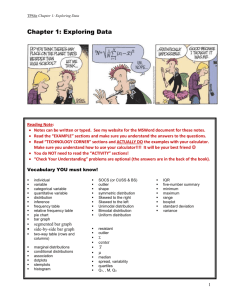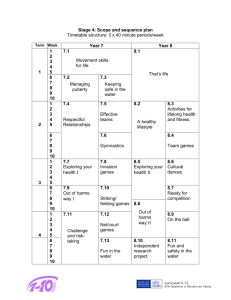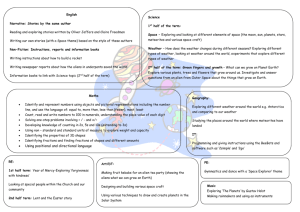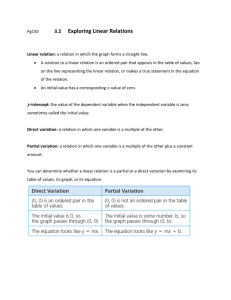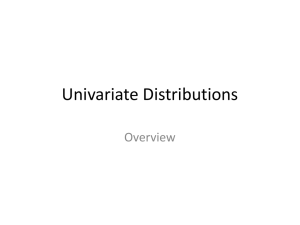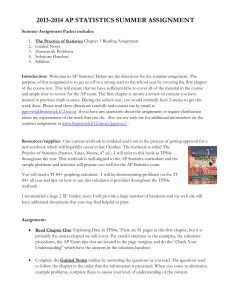AP-Stats-Chapter-1-Guided-Reading-Notes
advertisement
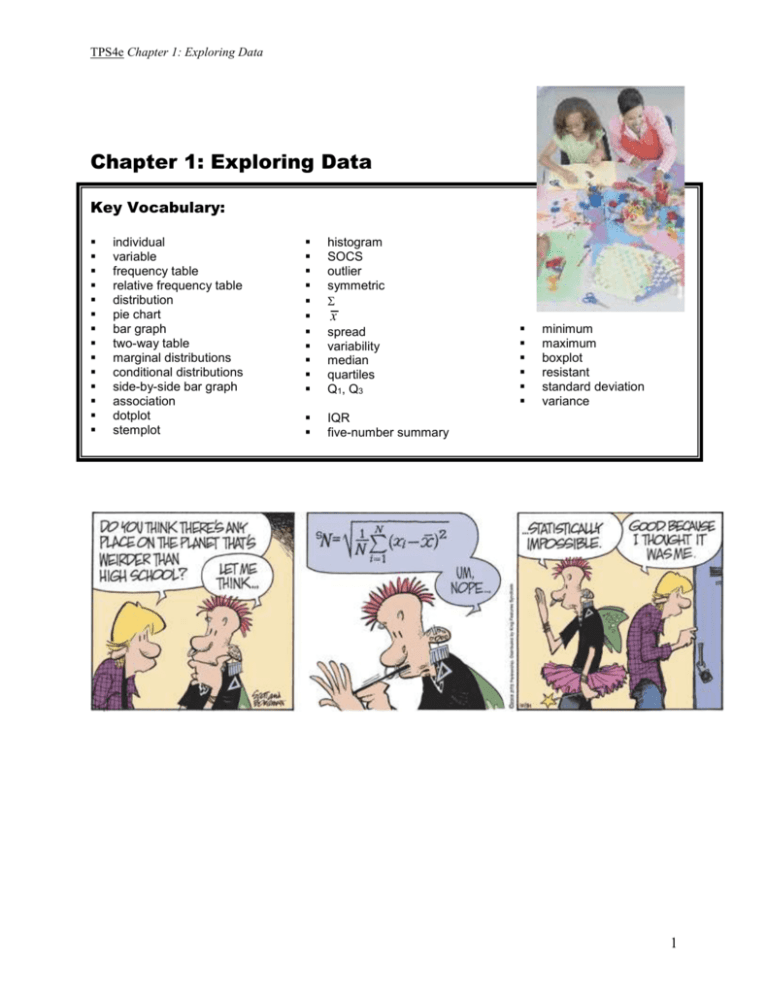
TPS4e Chapter 1: Exploring Data Chapter 1: Exploring Data Key Vocabulary: individual variable frequency table relative frequency table distribution pie chart bar graph two-way table marginal distributions conditional distributions side-by-side bar graph association dotplot stemplot histogram SOCS outlier symmetric IQR five-number summary x spread variability median quartiles Q1, Q3 minimum maximum boxplot resistant standard deviation variance 1 TPS4e Chapter 1: Exploring Data Data Analysis: Making Sense of Data (pp.2-6) 1. Individuals are… 2. A variable (IT IS NOT X) is … 3. When you first meet a new data set, ask yourself: Who… What… Why, When, Where and How… 4. Explain the difference between a categorical variable and a quantitative variable. Give an example of each. 5. Give an example of a categorical variable that has number values. 6. Define distribution: Give an example of a distribution: 6. Answer the two questions for the Check Your Understanding on page 5: 7. Define inference. 2 TPS4e Chapter 1: Exploring Data 1.1 Analyzing Categorical Data (pp.8-22) 1. A frequency table displays… 2. A relative frequency table displays… 3. What type of data are pie charts and bar graphs used for? 4. Categories in a bar graph are represented by _______________________ and the bar heights give the category _________________________________________. 5. What is a two-way table? 6. Define marginal distribution. 7. Answer the two questions for the Check Your Understanding on page 14. 8. What is a conditional distribution? Give an example demonstrating how to calculate one set of conditional distributions in a two-way table. 3 TPS4e Chapter 1: Exploring Data 9. What is the purpose of using a segmented bar graph? 10. Answer question one for the Check Your Understanding on page 17. 11. Describe the four steps to organizing a statistical problem: State… Plan… Do… Conclude… 12. Explain what it meant by an association between two variables; Give an example. 13. SKIP SIMPSON’S PARODOX. 4 TPS4e Chapter 1: Exploring Data 1.2 Analyzing Categorical Data (pp.27-42) 1. What is a dotplot? When would you use it? Draw an example. 2. [VERY IMPORTANT CONCEPT!!] When examining a distribution, you can describe the overall pattern by its S___________ O__________ C________ S_________ I call this CUSS and BS. You can use either mnemonic. Center, Unusual, Shape, Spread and Be Specific, Make sure you understand how to compare distributions in context. 3. Describe Shape a) If a distribution is symmetric, what does it look like? b) If a distribution is skewed to the right, what does it look like? c) If a distribution is skewed to the left, what does it look like? d) Describe and illustrate the following distributions: i) Unimodal ii) Bimodal iii) Multimodal 5 TPS4e Chapter 1: Exploring Data 4. Answer questions in Check Your Understanding on page 31. 5. How are a stemplot and a histogram similar? 6. When is it beneficial to split the stems on a stemplot? 7. When is it best to use a back-to-back stemplot? 8. Answer questions in Check Your Understanding on page 34. 6 TPS4e Chapter 1: Exploring Data 9. List the three steps involved in making a histogram. 10. Why is it advantageous to use a relative frequency histogram instead of a frequency histogram? 11. Do Technology Corner (page 38) problem and sketch your graphs. 12. Answer Check Your Understanding questions on pages 39. 13. Answer Check Your Understanding questions on pages 41. 7 TPS4e Chapter 1: Exploring Data 1.3 Analyzing Categorical Data (pp.50-67) Describe Center 1. Explain how to calculate by hand and find on the calculator the mean, x (Xbar). 2. What is the meaning of (sigma)? 3. Explain the difference between x and (mu). 4. Define resistant measure. 5. Explain why the mean is not a resistant measure of center. 6. What is the median of a distribution? Explain how to calculate by hand and find on the calculator. 7. Explain why the median is a resistant measure of center? 8 TPS4e Chapter 1: Exploring Data Describe Center (continued) 8. How does the shape of the distribution affect the mean and median? 9. Answer Check Your Understanding questions on page 55. Describe Spread and Outliers 10. What is the range? 11. Is the range a resistant measure of spread? Explain. 12. How do you find first quartile Q1 and third quartile Q3 by hand and find on the calculator. 9 TPS4e Chapter 1: Exploring Data Describe Spread and Outliers (continued) 13. What is the Interquartile Range (IQR)? 14. Is the IQR and the quartiles a resistant measure of spread? Explain. 15. How is the IQR used to identify outliers? 16. What is the five-number summary of a distribution? 17. Explain how to use the five-number summary to make a boxplot. 10 TPS4e Chapter 1: Exploring Data 18. Answer Check Your Understanding questions on page 61. 19. Do Technology Corner (page 61) problem and sketch your graphs. 11 TPS4e Chapter 1: Exploring Data Describe Spread and Outliers (continued) . 20. What does the standard deviation(S or Sx) measure? b) How do we calculate it by hand and find on the calculator. 21. What is the relationship between variance (S2x or S2) and standard deviation (Sx or S)? Why do we prefer to use standard deviation and NOT variance? 22. What are the 4 properties of the standard deviation explained on page 64? 23. Answer Check Your Understanding questions on page 64. 24. Do Technology Corner (page 65) problem and give the summary statistics 25. How should one go about choosing measures of center and spread? 12
